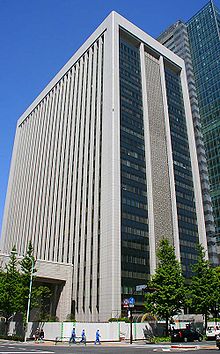Mitsubishi Bank


The Mitsubishi Bank (株式会社三菱銀行, Kabushiki gaisha Mitsubishi Ginkō) was a major Japanese bank headquartered in Tokyo, founded in 1880. For much of the 20th century it was one of the largest Japanese banks, together with Dai-Ichi Bank, Mitsui Bank, Sumitomo Bank, and Yasuda Bank / Fuji Bank.[1]. It served as the main bank for the Mitsubishi conglomerate.[2] In 1948, the Mitsubishi conglomerate was dismantled and the bank was renamed Chiyoda Bank (千代田銀行, Chiyoda Ginkō) after the Chiyoda district in Tokyo, then reverted to the Mitsubishi name in 1953.
Mitsubishi Bank merged with the Bank of Tokyo in 1996 to form Bank of Tokyo-Mitsubishi, a predecessor of MUFG Bank.
Overview
[edit]The bank's operations date to 1880, when Mitsubishi group founder Yataro Iwasaki established the Mitsubishi Exchange House (三菱為替店, Mitsubishi Kawaseten) in Tokyo. Mitsubishi acquired the business of the Tokyo, Oita and Hakodate-based 119th National Bank in 1885, and spun this business off to an independent Mitsubishi Bank in 1919. The bank opened branches in London and New York in 1920.[3] By 1929, Mitsubishi Bank had only 3 offices outside of Japan and its colonies, less than Mitsui bank or Sumitomo Bank and much less than the Yokohama Specie Bank, Bank of Chōsen and Bank of Taiwan, for which foreign trade was part of a public-interest mandate under special legislation.[4]: 3
During World War II, Mitsubishi Bank was a financier of Japanese interests in Manchuria through its branch in Dalian, opened in 1933.[2] Its London and New York offices closed during the war, but reopened in 1953.[citation needed]
In 1969, Mitsubishi and Dai-Ichi Bank, Japan's oldest bank, began preparations for a merger, which would have led to a major regrouping in the bank-led keiretsu system of the era. But the plan met opposition among Dai-Ichi's management and its customers in the Furukawa and Kawasaki groups, who feared that Mitsubishi would dominate the combined bank and that their businesses would be absorbed by the relatively strong Mitsubishi group. As a result, the merger was called off. Two years later, Dai-Ichi merged with Nippon Kangyo Bank to form Dai-Ichi Kangyo Bank.[5]
Mitsubishi was known as a very conservative lender and was one of the few Japanese banks to emerge from the Japanese asset price bubble relatively unscathed. It acquired the Nippon Trust Bank in 1994.[2] In 1996, it combined with The Bank of Tokyo to form The Bank of Tokyo-Mitsubishi.
In addition to its home country of Japan, Mitsubishi was also active in California, where it began banking operations in 1972 through Mitsubishi Bank of California.[2] Mitsubishi acquired Bank of California in 1984, which later merged with Bank of Tokyo-controlled Union Bank to form what is now known as MUFG Union Bank.[6]
Notable alumni
[edit]- Zentaro Kosaka, politician and Japanese foreign minister
- Makoto Usami, Bank of Japan president
References
[edit]- ^ David A. Alhadeff (1975), "Bank-Business Conglomerates - the Japanese Experience", Quarterly Review of Economics and Finance
- ^ a b c d "Bank of Tokyo-Mitsubishi Ltd. History". International Directory of Company Histories, Vol. 15. St. James Press, 1996. Retrieved 10 April 2015.
- ^ "The Origins of Our Bank". MUFG Bank. Retrieved 10 April 2015.
- ^ Makoto Kasuya (January 2009), The Activities of a Japanese Bank in the Interwar Financial Centers: A Case of the Yokohama Specie Bank (PDF), Center for Advanced Research in Finance
- ^ Sato, Kazuo (18 October 2010). The Anatomy of Japanese Business. Routledge. p. 156. ISBN 9781136910135. Retrieved 10 April 2015.
- ^ "Union Bank's History". MUFG Union Bank. Archived from the original on 17 April 2015. Retrieved 10 April 2015.
- Defunct banks of Japan
- Mitsubishi companies
- Mitsubishi UFJ Financial Group
- Financial services companies based in Tokyo
- Japanese companies established in 1919
- Banks established in 1919
- Banks disestablished in 1996
- Companies formerly listed on the Tokyo Stock Exchange
- Japanese companies disestablished in 1996
- 1996 mergers and acquisitions

